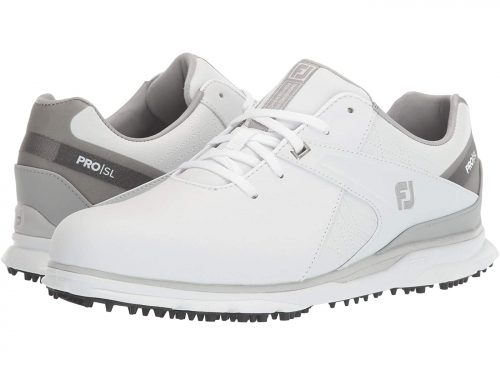While the debate regarding the necessity of golf shoes has not been concluded still, all golf players would agree that golf shoes are remarkably useful. They were designed for this sport in particular and are meant to cater to the specific circumstances of the golfing environment and playstyles.
Today we’ll talk about the importance of golf shoes; are they worth the money, can they impact your performance, can you feel more natural by wearing them, and ultimately, are they really necessary for golf players, or could you use your old pair of sneakers instead?
The design of the golfing shoe promotes balance
Golfing shoes are purposefully different from most other types of athletic shoes and sneakers. First and foremost, they have a much larger sole, as well as a slightly broader base. Although they may not be ideal for commuting due to their increased weight and size, these elements are actually favorable when it comes to finding balance and centering your shot.
Golf players don’t make as many foot motions as runners, or football players. Smaller shoes with small bases are meant to promote flexibility and allow athletes to sustain dozens of motions per second, while golfers typically stand still while charging up a shot.
Golfing shoes and swinging stability
While performing a swing, golfers perform a full-body motion, relying on the stability of their feet for accuracy and precision. In other words, stable feet support stable hands, which support both swinging speed and accuracy.
The weight and size of golf shoes keep the player’s feet firmly on the ground, locked in place so that the arms can freely concentrate on executing a perfect swing.
It’s debatable whether golfing shoes can influence the swinging speed directly. Most players who wear high-quality golf shoes may get the feeling that their swinging speed has improved, but that could also be attributed to the confidence gained from improved balance and stability.
Golfing comfort
The pace of a golf game is much different from the pace of a 100-meter race, or a 90-minute football match. A game of golf can last an hour, but most players need at least several to simply walk the entire course without taking a single swing.
In terms of fatigue and energy consumption, the players will inevitably become tired, as they’ll spend multiple hours on their feet while performing fierce swings with their arms. Golfing shoes are important because they offer the players exactly what they need on the field, which is stability, durability, and freedom of movement on all types of terrain.
Traditional parameters of comfort do not necessarily apply to ‘golfing comfort’. Golfing shoes are obviously bigger, bulkier, and heavier than standard athletic footwear, so most people would immediately assume they are nothing but a ‘necessary’ hindrance.
The added weight actually supports the typical positions golfers maintain during the game while the bigger size allows players to be more accurate. Most models featured padded insoles for added comfort, and the majority of golf shoes are fairly breathable.
Golf & Style
Golf is a game that exudes elegance and style. Even if we were to neglect the impact of golf shoes in other (more practical) departments, they are currently the most aesthetically complete pieces of footwear that players can wear.
Golfing shoes are designed to blend the worlds of fashion and sports, which applies even to the cheapest of pairs. The heeled design with subtle laces, quality leather, and waterproof coatings are some of the most typical features of a standard golfing shoe. As fashion trends shift, newer and more elegant models are being delivered to the shelves of golfing venues worldwide.
All-terrain suitability
There are many types of environments that golfers can encounter on a single course. While clear-cut grass is the default, you will encounter rocks, water, mud, debris, sand, and similar ‘obstacles’ on different courses, and if you hope of completing a course without tiring yourself out halfway through, you should pick appropriate footwear in advance.
While running sneakers are perfect for grass, they tend to provide less comfort and joint support on rocky terrains. Most types of active footwear fares better in these fields, although waterproof shoes are generally best in muddy environments and courses where river passages are present.
Multiple types of golfing shoes provided even more versatility
There are four main types of golfing shoes that allow players to prepare even better for the hardships of particular terrains found on different golf courses. The importance and relevance of golfing shoes is best seen through the different types that are currently available, as each offers different benefits:
Spiked shoes
One of the most popular types is the spiked golf shoe. Essentially, it’s a heeled shoe that offers superior traction. They are generally believed to offer tremendous boons to the player’s swinging performance, as they are remarkably stable and grippy.
Spiked shoes stick to the ground firmly, and they’re especially efficient when used on traditional grassy courses, but they’re also great when used on sand. Most models are waterproof, or at least water-resistant.
The main drawback of spiked shoes is their weight. They aren’t that great in muddy environments, and their weight makes them less stable on rocky surfaces.
Spikeless shoes
Spikeless shoes, otherwise called ‘street shoes’, are relatively new to the market. The vast majority of models were designed to fit the most recent urban trends, which makes them perfect for both golf practice and commuting. Although they may not be as stylish as traditional spiked shoes, they are certainly classy and belong to younger generations aesthetically and stylistically.
Spikeless shoes are designed with low-profile and are generally considerably lighter than their spiked counterparts. Although they are called ‘spike-less’, they actually feature small bumps on the soles that provide a boost in terms of traction and grip.
During the initial years when the spikeless shoes were breaking onto the golfing market, their soles were deemed flimsy and hard to maintain and replace. With the many improvements in the field of rubber technologies, most brands have been able to counteract this little flaw.
Professionals and semi-pro golfers have embraced this newer design, as it offers more flexibility, and a new outlook. Performance-wise, spikeless shoes are pretty decent when used on firm surfaces. They are better-rounded and can tackle sand and mud better than spiked shoes, but they don’t provide the same level of stability on grassy terrain.
The main trade-off with spikeless shoes is their inferior grip and the lack of waterproofing. Although players could manually apply a coat of waterproof spray, they can’t compare to spiked shoes in this department.
Golf boots
Golfers who have accustomed to the rough courses along the coasts of Seattle, Washington, Los Angeles, and San Francisco probably don’t need boots to wade through knee-deep waters or mud while trying to find their ball. However, players who’ve mainly played inland grassy courses would probably be discouraged by such experiences.
Golf boots were invented to provide unparalleled protection and comfort in particularly harsh natural environments. Although they aren’t nearly as flexible or breathable as regular golfing shoes, golf boots are more of a necessity for courses where yards of rock, mud, sand, and stone are a commonplace.






